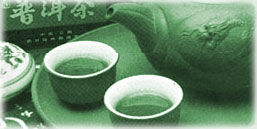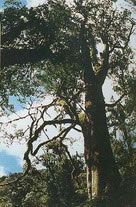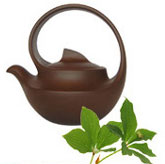Name Forms:
 Pu'er tea is also known as Puer, Puerh, P'uerh, or commonly indexed in
the Western encyclopedias as "Pu-erh". Pu'er tea is also known as Puer, Puerh, P'uerh, or commonly indexed in
the Western encyclopedias as "Pu-erh".
Traditional Chinese:

Characteristics:
普洱茶 or Pu'er is the most famous and popular style of Black tea. Chinese Black
teas are prized for their ability to naturally age, and develop different aromas
and flavors over the years. Traditionally (but not necessarily) compressed
into different shapes for easier storage and transport. Pu'er is the
primary style of tea for long-term financial investment. In general, Pu'er is
made from tea leaves that are then processed into a variety of shapes and sizes.
This is the only tea in the world that actually increases in value with age,
much like a fine wine. However, it does not obtain its true depth of flavor
until it has had the opportunity to age and mellow for a minimum of several
years.
History:
 The history of Pu'er tea begins over 1,000 years ago. During the Tang
Dynasty (A.D. 618-907) China began exporting tea to nations such as Mongolia,
Tibet, Burma and the Middle East. To make tea easier to carry, the loose
leaves were compressed into various sizes and shapes such as disks/cakes,
bricks, or bowls. The traditional methods of crafting Pu'er tea continue to
this day. Pu'er tea derives its name from the market town of Pu-er, where it was
originally processed and sold, but it is grown on the Nuoshan Mountains. It is
said that the unique taste of Pu'er Tea was developed because it took weeks to
transport the tea leaves by horseback to the town to be processed. During this
transportation period the tea leaves would begin to ferment in the humidity and
release a strong, fragrant aroma, which people found quite pleasant. A special
technique of tea fermenting developed and Pu'er was thus created. The history of Pu'er tea begins over 1,000 years ago. During the Tang
Dynasty (A.D. 618-907) China began exporting tea to nations such as Mongolia,
Tibet, Burma and the Middle East. To make tea easier to carry, the loose
leaves were compressed into various sizes and shapes such as disks/cakes,
bricks, or bowls. The traditional methods of crafting Pu'er tea continue to
this day. Pu'er tea derives its name from the market town of Pu-er, where it was
originally processed and sold, but it is grown on the Nuoshan Mountains. It is
said that the unique taste of Pu'er Tea was developed because it took weeks to
transport the tea leaves by horseback to the town to be processed. During this
transportation period the tea leaves would begin to ferment in the humidity and
release a strong, fragrant aroma, which people found quite pleasant. A special
technique of tea fermenting developed and Pu'er was thus created.
Tasting & Aging:
Pu'er teas begin with a similar flavor to green teas, with the added potential
and intention for natural aging. Overtime the leaves transform from green to
amber and finally to a dark teak, therefore the name Black tea. Young Pu'er teas
are bright and refreshing. Their flavor and aroma can be warm and citric
to grassy and herbal. As Pu'er ages, significant layers of flavors and nuances
evolve. Fruit notes ripen, and aromas of exotic woods develop over the years.
Frequently Asked Questions & Answers About Pu'er Tea
Are Pu'er teas only produced in the Yunnan Province?
 Yes,
if you want the most authentic and best of the best. No, if you will settle for
similar but much lower quality Pu'er teas produced in other provinces such as
Hunan and Guangdong, or even in other countries such as Vietnam, Laos, and
Burma. Keep in mind that high quality, authentic Pu'er teas must be produced from tea plants native to Yunnan
Province and processed according to the traditional methods officially outlined
by the Yunnan Provincial Bureau of Quality and Technique Supervision. Ten Fu's Tea
currently only carries 100% authentic and true-to-grade Pu'er teas originating
from the Yunnan Province of China. Yes,
if you want the most authentic and best of the best. No, if you will settle for
similar but much lower quality Pu'er teas produced in other provinces such as
Hunan and Guangdong, or even in other countries such as Vietnam, Laos, and
Burma. Keep in mind that high quality, authentic Pu'er teas must be produced from tea plants native to Yunnan
Province and processed according to the traditional methods officially outlined
by the Yunnan Provincial Bureau of Quality and Technique Supervision. Ten Fu's Tea
currently only carries 100% authentic and true-to-grade Pu'er teas originating
from the Yunnan Province of China.
How are Pu'er teas made?
The typical production process involves:
- Harvesting (best quality when harvested during
Spring, then Fall)
- Wok roasting to deactivate the enzymes
- Rolling / Kneading
- Sun drying
- Grading and separating of leaves
- Blending (if desired)
- Lightly steam and then compress into various shapes and sizes
- Dried naturally on racks, or aided with heat during rainy and humid
environments.
- Packaging and storing/shipping
How should I store Pu'er?
Pu'er tea and other black teas should be stored in a cool dry environment.
Kitchen odors and other air pollutants should be avoided. Care should be taken
to prevent tea from being subjected to light.
Black teas can tolerate natural changes in temperature and relative humidity,
unless you live in a tropical or sub-tropical environment where the relative
humidity and temperature is constantly high. De-humidifiers and air-conditioned
environments are required where the natural humidity and temperature is very
high.
What is the difference between dry storage and wet storage?
As the names imply, dry storage is the storing of teas in a dry environment.
Some teas are stored in a very humid environment, which is called wet storage.
The excessive humidity causes the tea to quickly breakdown, making the tea
leaves turn a dark color and the drink mellow. Tea merchants use wet
storage to make their teas transform quickly and avoid investing fifteen to
twenty years for the tea to age naturally.
Dry storage is more desirable. Although the aging process in dry storage is
generally slower, a much more vibrant tea with greater nuances of flavor and
aroma are developed.
What is live/green/raw Pu'er?
Live Pu'er, also known as green, or raw Pu'er, is Pu'er tea that has not been
subjected to excessive moisture and humidity.
Mature Pu'er that has been aged for twenty years or more is seldom referred
to with such terms, although these terms can be used to indicate the proper
quality and storage of aged Pu'er.
What is cooked, and what is semi-cooked Pu'er?
Cooked tea is the result of using humidity and moisture to speed the change
in black teas. When the humidity and moisture has thoroughly penetrated
the leaves it is called cooked tea. If the tea has not been thoroughly
damaged and still maintains some of its vibrancy, the tea is called semi-cooked,
or semi-raw.
What is meant by hydro-fermented and pile-fermented?
Cooked tea may also be called hydro-fermented or pile-fermented. During
processing, the tea leaves are moistened and often piled to allow the humidity
and heat to build up. The hydro-fermentation of black tea should not be
mistaken with the fermentation of oolong tea and red tea. Fermentation of oolong
tea and red tea refers only to the exposing and natural oxidizing of the tea
leaves and its juices.
Is Live Pu'er the same as Dry Storage Pu'er?
Live Pu'er should never be subjected to excessive humidity, therefore it
should necessarily be dry storage Pu'er. Proper dry storage from the time of
manufacture will allow the character of the tea to develop unhindered, and
preserve its original vibrancy.
However, even fully cooked and semi-cooked Pu'er tea is often placed in dry
storage after processing to limit and reduce the musty character commonly
associated with cooked Pu'er. These teas can legitimately be called dry
storage tea, but they are not the same as live Pu'er that has been aged in dry
storage.
Do different shapes represent different quality?
Not necessarily.
Pu'er disks/cakes are the most favored shape. Therefore, most of the highest
quality tea leaves tend to be used for tea cakes. It would be a mistake to
simply dismiss other shapes of black teas. High quality tea leaves are
also used in bricks and other decorative shapes.
Since there is a higher demand for tea cakes, high quality tea made in other
shapes can sometimes be purchased at undervalued prices.
Why do I hear that people "collect" Pu'er teas?
Because of value, much like collecting fine wines.
Choice, well aged vintages can demand thousands of dollars. Unlike any other
teas, Pu'er tea increases in value when aged properly. The quality and taste
increases with age, and therefore, Pu'er tea can become a valued collectible for
any interested individuals. Many collectors have Pu'er cellars full of cakes of
every shape and sizes.
What are the known health benefits of Pu'er tea?
 (Please note that the following list of benefits
have been collected from public sources and should not be taken as absolute facts!
For informational and proper health care providing, always check with your physician!) (Please note that the following list of benefits
have been collected from public sources and should not be taken as absolute facts!
For informational and proper health care providing, always check with your physician!)
Pu'er tea has been celebrated since the Tang Dynasty (618 A.D. - 906 A.D.) for its health benefits and curative powers in certain diseases. Modern medical science has recently shown that the health benefits of Pu'er tea may be more than just Chinese folklore. Since 1970 France, Japan and China have been conducting many scientific studies on Pu'er tea which suggest that it may:
-
reduce cholesterol in the blood stream
-
reduce body weight
-
help
to reduce high blood pressure, heart & liver diseases related to high
saturated fat diets
-
detoxify the liver
-
help
prevent intestinal infection, digestive problems and constipation
-
help
to prevent the formation of cancer cells in the body due to its
anti-oxidants
|